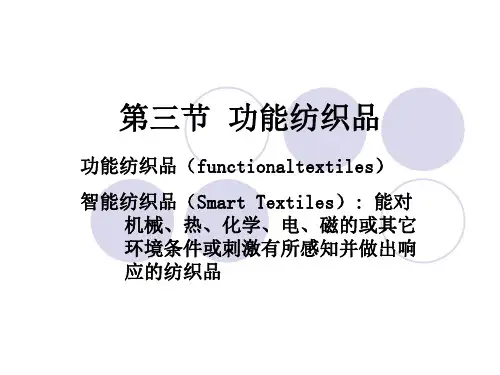• 从目前世界上已有和正在开发的智能纺织品的品种来看, 纺织品的智能化一般是通过以下途径来实现的。
• (1)智能材料的开发是智能纺织品开发的基础。利用高分子
化学和物理原理,合成能对环境刺激进行响应的智能高聚 物,或对原有的高聚物或天然高分子进行改性,使其具有 智能化特征。例如通过对“变色脂”表皮颜色变化机理的 研究,已研制出一种变色 蛋白质纤维,用以制成织物, 就可做成对某些特定刺激(如光、热等)进行响应的变色服 装。
Cont.
• Smart materials and structures can be defined as the materials and structures that sense and react to environmental conditions or stimuli, such as those from mechanical, thermal, chemical, electrical, magnetic or other sources. According to the manner of reaction, they can be divided into passive smart, active smart and very smart materials. Passive smart materials can only sense the environmental conditions or stimuli; active smart materials will sense and react to the conditions or stimuli; very smart materials can sense, react and adapt themselves accordingly. An even higher level of intelligence can be achieved from those intelligent materials and structures capable of responding or activated to perform a function in a manual or preprogrammed manner.








